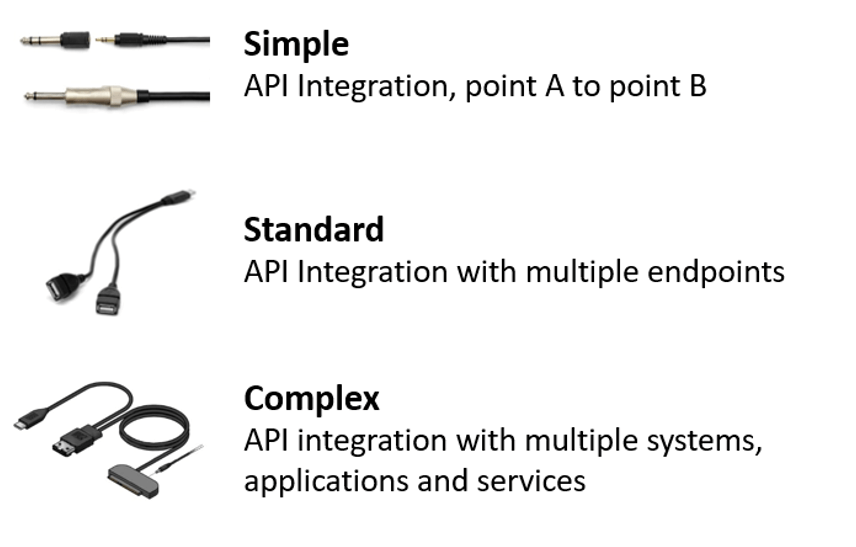What is API Integration?

APIs are used in a variety of scenarios to transfer data from A to B and thereby generate added value. In the B2B and B2C sectors, from banking and energy suppliers to the IIoT environment – whenever functional units are connected to each other so that data from a wide variety of sources can be collected and used via different connections, API integration is necessary.
Using many illustrative examples, we answer the question “What is API integration and how does it work?”
What is API Integration – your key to ensure smooth communicationHow can data be obtained and used from different sources and via different interfaces? With API integration. In order for connected functional units to be able to communicate with each other, a translation is required, and an interface handles the translation. For APIs, this translation is called API integration. The API is connected to a data source. Incoming requests (e.g. via a REST API or SOAP) must be able to be translated into a compatible form. The target structure of the adjacent functional units can be very different from the outgoing data unit, which can complicate mediation. The outgoing response must also be in the appropriate format. All these translation tasks are completed in the API integration process. In addition, an API does not necessarily have to be associated with only one functional unit, as described above. An API request must be placed into various request types on different backend systems in order to provide a standardized response. Since the respective backend systems can communicate in different ways, a multidimensional API integration is necessary. |
API Integration Types
For the purpose of this document, the image below illustrates three types of API integration.

Simple APIs can be integrated quickly and easily by a programmer in a matter of days.
If API integration is based on multiple endpoints and a process needs to be managed or synchronized, the integration becomes more complicated, the deployment effort is increased and developers have more to do. This is a standard integration.
It is more challenging to perform complex API integration with multiple systems, applications and services. Some may provide REST API interfaces, others may not, requiring a wider range of integration capabilities to enable implementation.
API Integration Challenge
When a company implements and integrates multiple APIs, the result can be the dreaded integration spaghetti.

Your goal should be to avoid the proliferation of APIs in your company. The use of APIs for most types of integration requirements at most companies is not regulated, so you need to properly maintain and manage them with API management.
Use Cases for API Integration
Cloud: The cloud offers enormous advantages in terms of costs, scalability and flexibility. But if you want to use cloud applications such as Salesforce, you have to connect your own systems to theirs and ensure, for example, that their service can use the existing customer master data from the ERP system. However, access to internal data must be secure and controlled, since it involves business-critical systems and sensitive information.
| The solution: APIs that allow targeted access to required data and functions. |
Mobile App: Mobile apps make business processes and employees more flexible, efficient and productive, and they help to integrate customers and partners with the business. Mobile apps also require access to relevant company data, which is usually protected behind firewalls in complex business systems and databases.
| APIs enable secure and controlled access to the necessary data from the outside and thus enable a variety of mobile applications. |
API-based B2B Integration
API integration should not be seen as a substitute for B2B integration, which uses batch-driven approaches such as EDI- and XML-based mass data exchange.
| As a complement to EDI, API integration is brings closer integration of business partners and is used by the business to provide better services. |
Many companies provide real-time pricing and inventory information to their merchants via APIs. They can use APIs to feed the data directly into their shop systems, ensuring they always have up-to-date and accurate information.
Data as a Service
For example, Data as a Service is the service provided by the Google Maps API or the API that provides access to Twitter. APIs such as this can be groundbreaking for companies that want to add valuable services to their offering. APIs can also be used to analyze marketing campaigns. For example, you can measure the success of a LinkedIn ad campaign. First, the number of likes is assessed and compared with the sales reports, which are directly integrated into a data lake by EDI from the points of sale. Data analysts can then use this information to uncover whether or not the LinkedIn ad is helping to improve sales performance at the retailers’ point of sale. Through API-based data, retailers are now able to measure and evaluate the success of individual campaigns across multiple data points.
Industry initiatives such as Open Banking
APIs and the use of APIs are being standardized in multiple industries across the globe. Standards, mandates and industry initiatives help to establish a new technology or approach quickly. One powerful driver, the idea about Open Banking, forces financial service providers to securely share or openly publish customer data via open APIs, enabling others, such as FinTech start-ups, to build their business without any technical barriers. The Berlin Group, a European payments interoperability standards initiative, has defined API-based standards for Open Banking. Other industries such as healthcare are following suit. In fact, SEEBURGER AG is involved in the UN/CEFACT to promote standardization in the logistics sector.
But deploying and integrating the different types of APIs is only half the battle. An API management layer is necessary to be able to use APIs purposefully. You can learn all about API management in our blog “What is API Management” and “What is API Full Lifecycle Management“. Furthermore you should know “How API Management Projects Go Awry If You Forget About API Integration”
Thank you for your message
We appreciate your interest in SEEBURGER
Get in contact with us:
Please enter details about your project in the message section so we can direct your inquiry to the right consultant.
Written by: Thomas Kamper
Thomas Kamper, SVP Strategic Product Management, is responsible for strategic product initiatives related to all SEEBURGER’s business integration technology and solutions. The focus is currently on API solutions and Big Data. In addition, he is responsible for solutions that enable organizations to master challenges of visibility and to control the proper execution of digitalized business processes. Thomas rejoined SEEBURGER December 2017. Before, he worked for many years as a hands-on interim manager and business advisor supporting C-level executives within software and cloud service providers to make their strategic product initiatives successful.





